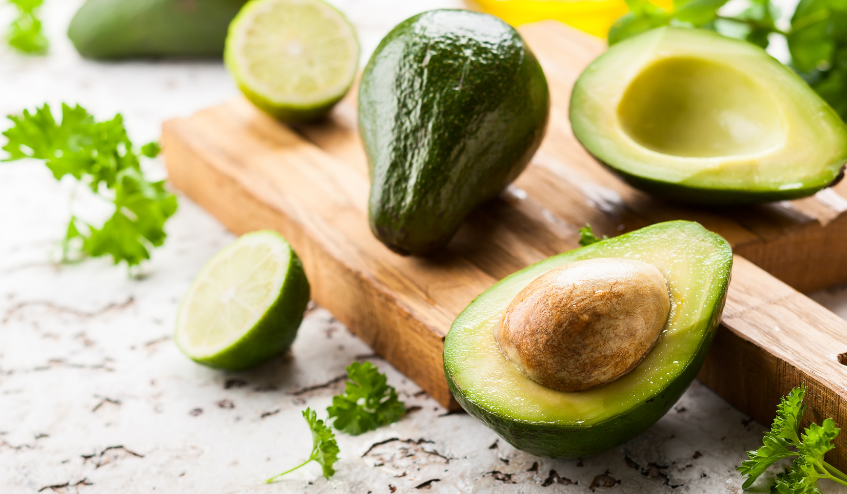Avocados are luscious, creamy, and so versatile! They add body and moisture to recipes while providing a large nutritional punch.
avocado | noun
- a pear-shaped fruit with a rough leathery skin, smooth oily edible flesh, and a large stone
- an edible fruit of various tropical American trees of the laurel family
- also known as “alligator pear”
Avocados are one of those foods which I did not really discover until I was an adult. They simply were not an ingredient used in the Midwestern meat and potatoes meals of my childhood. I am not certain when I first tasted one, but do know it was in a restaurant, and most likely in guacamole. For whatever reason, they left an impression on me and have subsequently always felt like something special. Today, there is almost always an avocado (or two or three…) on my kitchen counter or in my refrigerator.
Avocados are grown commercially worldwide in warm tropical or Mediterranean climates. Mexico, several Latin American and Caribbean countries, and Indonesia have long been the top producers. In the United States, avocados are grown commercially in Florida, California, and Hawaii.
There are hundreds of different avocado varieties grown across the world, yet two types are most familiar to us in the United States – California (or Haas) avocados and Florida avocados. Most likely you’ve seen each of these varieties in your local grocery store. California Haas avocados are smaller in size, have dark green skin with well-defined ridges or bumps, and present what is commonly referred to as “avocado green” colored fruit inside. Florida avocados are larger in size with smoother, lighter green skin, and brighter yellow-green fruit inside.
California Haas avocados are prized for their higher healthy fat content, creamier texture, and richer flavor, while Florida avocados offer less fat, firmer texture, and a lighter flavor.
Over the 2022 winter months, you may have read about or experienced the supply chain issues that affected the shipping of avocados from Mexico to the United States, along with the price increases. The avocado supply chain issues seem to be easing, at least from what I can tell in my East Coast grocery stores.
WHAT’S SO SPECIAL ABOUT AVOCADOS?
For a small fruit, avocados pack a large nutritional punch. They are a delicious source of unsaturated fat. They are also loaded with fiber and health-boosting vitamins and minerals such as B-vitamins, potassium, folate, and antioxidants. The nutrients found in avocados help protect our eyes, support our heart, bones, and brain function, provide us with energy, and lessen the risk of cancer.
WHY I LIKE COOKING WITH AVOCADOS
Avocados are luscious, creamy, and so versatile! They can be:
- used fresh in any type of salad, sandwich or wrap, or as a finishing ingredient to entrees, bowls, soups or stews, almost anything!
- blended into dips, sauces, dressings, smoothies
- used in place of other fats in baked goods and desserts
They add body and moisture, yet do not impart an avocado flavor once blended in with other ingredients or cooked.
Served raw, avocado’s rich, buttery, slightly nutty flavor pairs well with leafy greens, vegetables, other fruits (like grapefruit, watermelon, and mango, to name a few), and plant and animal proteins.
photo: Getty Images
SELECT
Prime season for avocados is late winter into early spring, yet they are available year-round in grocery stores.
When selecting an avocado to use in a day or so after purchase, look for those with skins that are slightly darker, rather than those that are brighter green. Very gently press the avocado with a thumb – it should feel firm, yet give slightly. California Haas avocados will “give” more than Florida avocados.
If an avocado feels too soft or has dents, it is most likely overripe and past its prime. Avoid those that have dark or soft spots, cracks, or mold near the stem.
STORE
Avocados may feel firm when purchasing in the store, but will continue to ripen once in your home kitchen. They can be stored on the kitchen counter or in the refrigerator depending on when they will be used.
Kitchen Counter
If stored on the counter, an unripe, uncut avocado will ripen within a few days. To help the ripening process along, place the avocado into a paper bag along with an apple or kiwi. Apples and kiwi produce ethylene, a natural hormone, that furthers the ripening process. Close the bag and set it on to kitchen counter, checking it each day until the avocado is the desired ripeness.
Refrigerator
For those occasions in which the avocado is ripe but will not be used for a few days, slow the ripening process but storing the uncut avocado in the refrigerator.
Freezer
Avocados also freeze well. Simply peel, remove the pit, leave it cut in half, or slice or dice it, then place it into a freezer container or zip-lock bag. Drizzle the avocado with lemon or lime juice before sealing the container and freezing. Thaw before using.
To Avoid Browning
Once an avocado is cut, it will brown quickly. To avoid browning of a cut avocado, squeeze or brush the exposed part with lemon or lime juice and tightly wrap with plastic wrap, pushing out as much air as possible. A bit of oxidation may still take place which affects it visually, but the avocado is still safe to eat.
PREP
Prepping the rich fruit inside the firm outer shell requires a bit of cutting, peeling, and removal of the pit.
Wash
First, start by washing the outer shell. The shell will be discarded but it’s a good idea to remove any dirt or unwanted organisms from the outside before cutting into the fruit.
- Rinse the uncut avocado under cold water, then pat it dry with a paper or clean cloth towel.
Cut and Remove Pit
You’ve most likely seen the method of using a chef’s knife to cut an avocado in half, then remove the seed by firmly hitting the knife into the seed and twisting. While many use this method, I recommend using one of these simpler, much safer approaches.
- How to Cut and Peel an Avocado – from California Avocado
- 5 Tips to Help You Cut an Avocado Without Cutting Yourself – from California Avocado
- Put Away Your Knife and Save Your Fingers with This Fun Trick for Pitting an Avocado – from the Kitchn
Peel
Once the pit is removed, simply use a spoon to scoop the avocado fruit away from the shell. Place it onto a cutting board and slice or dice it as desired.
NOTE: If an avocado is very soft or mushy and is dark brown or black when cut into, discard it.
COOK
Mention “avocado”, and guacamole is one of the first things that comes to mind – it’s a favorite among many. Yet, avocados work extremely well in a variety of other, sometimes unexpected ways.
- add to salads, bowls, soups, stews, egg dishes, sushi rolls, fresh spring rolls, sandwiches or wraps, whole grains, and other side dishes
- stuff with seafood, whole grains, and veggies
- serve as an appetizer drizzled with vinaigrette or sprinkled with warm spices
- blend into dips, sauces, dressings, smoothies
- pickle it
- incorporate into deviled eggs
- make into a spread for toast, sandwiches or wraps
- use in baked goods and desserts such as cakes, ice cream, or chocolate mousse
- use as a replacement for butter or mayonnaise in recipes
FUN AVOCADO TIDBITS
According to the Spruce Eats,
The highest consumption of avocados in the U.S. occurs during the super bowl.
In other parts of the world, the avocado is treated very differently. The Taiwanese eat avocados with milk and sugar. Indonesians mix them with milk, coffee, and rum for a cold libation. Filipinos puree them with sugar and milk to make a dessert drink. In some parts of Mexico, the green and dried leaves are used to wrap tamales or as a seasoning for barbecues and stews.
photo: Love + Craft Kitchen
RECIPE
Grilled Salmon and Avocado Lettuce Wraps
And, for something on the sweet side, how about these avocado recipes:
- Chocolate Fudge Avocado Cake – McCormick
- 11 Must-Try Avocado Desserts – Food & Wine
SHARE
Have a favorite way to use or enjoy avocados? Share it with us in the comments section.
© 2022 Love + Craft Kitchen, LLC, All Rights Reserved
Main photo: Getty Images


Recent Comments